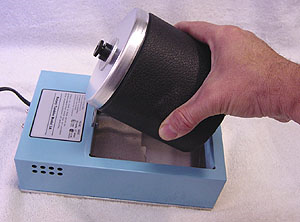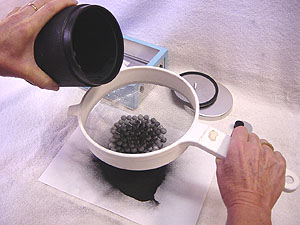BLACK POWDER
Black Powder is the backbone of pyrotechnics. After all, it's black powder that gives fireworks the smell we all love so much. Black powder is the main ingredient in a variety of firework and rocket formulas. You can easily make your own high quality black powder with just a few chemicals and a ball mill.
BASICS
Black powder is also known by a couple of other names. The most common is Gun Powder. Black powder is produced in large quantities commercially, and sold in small 1 pound containers, mainly for use in antique black powder guns. It is also normally sold in different granulations, and they indicate how fine the black powder is granulated by how many "F's" they put on the container. Coarse granulations are called "FG or FFG" (aka "1Fg" and "2Fg"). Finer granulations are "FFFg and "FFFFg" (aka 3Fg and 4Fg). The more "F's", the finer the black powder...and the finer the black powder is, the faster it burns. Small (fine) granulations burn faster and are used in small bore guns, where larger (coarser) granulations are used for larger bore guns and cannons, and for launching aerial shells out of mortars. Using a finer granulation for these jobs puts too much strain on the gun (or shell or mortar) because the powder burns much faster and creates a fast pressure increase that could damage whatever you're trying to launch, or the gun/mortar itself. Coarser, granulated black powder that is used in mortars to launch shells, or in Roman Candles to shoot out stars, is sometimes called "lift powder." When black powder isn't granulated, and is in a super fine powder state (similar to that of Talcum powder) it is called "meal powder." Just to confuse things even more, any granulated black powder is also sometimes called "grain powder."
Smokeless Powder (Pyrodex, etc.) is not to be confused with black powder. It is actually nitrocellulose, and cannot be used in place of black powder. Now, why they needed 5 names to describe one substance is beyond us, but just keep in mind that black powder, gun powder, lift powder, grain powder, and meal powder are really all the same material. 30 years ago (when I was 13), I sat picking the raisins out of Oatmeal because I thought meal powder was just finely powdered Oatmeal. Needless to say, the rocket engine I was building didn't work, as Oatmeal doesn't have quite the kick that black powder does. On the other hand, black powder makes a terrible breakfast.
Anyway, as far as fireworks are concerned, black powder is used both in its finely powdered form (meal powder) for coating stars and for mixing in other pyrotechnic formulas, and in its granulated form (lift powder) for launching shells out of a mortar, or stars out of a Roman Candle.
The formula for black powder is 75% potassium nitrate, 15% charcoal, and 10% sulfur, and like all formulas, it is measured by weight only. However, unlike many pyrotechnic formulas, you just can't mix these chemicals together and expect to have black powder. The mixing process for black powder is just as important as the formula. Black powder MUST be made in a ball mill to work properly. A ball mill is a rotating drum with dozens of lead balls inside. The 3 chemicals are loaded into the ball mill, along with the lead balls, sealed shut and allowed to rotate for anywhere between 1 and 24 hours. As the ball mill rotates, the lead balls will crush the chemicals together, forcing some of the potassium nitrate into the pores of the charcoal and sulfur. At the same time, the entire mass will be reduced to a super fine powder. The longer the ball mill runs, the stronger the black powder will be. A general rule of thumb for all pyrotechnic mixtures is "the finer the powder is, the faster it will burn." ONLY lead balls can be used in a ball mill as they are completely non-sparking. ONLY black powder can be mixed in a ball mill. Other pyrotechnic mixtures such as flash powder CAN NOT, as they are too sensitive and will explode. Individual chemicals, however, can also be ball-milled into a fine powder, but the mill must be cleaned before this is done.
Once the mill has run for a while, it can be opened and the lead balls separated from the fine meal powder. As we'll show you below, this meal powder can now be used to make all the other forms of black powder for use in fireworks.
BLACK POWDER vs. FLASH POWDER
A lot of people ask which is stronger, black powder or flash powder, or if black powder can be used in Salutes (exploding fireworks). In short, there is no comparison. Flash powder is a high explosive; a shattering explosive. It converts to a gas so quickly that objects near it, and containers that hold it cannot move out of the way (or vent) fast enough to release this gas, so they are destroyed into fragments. Black powder is a low explosive; a heaving explosive. It converts to gas much more slowly than flash powder, and generally pushes things as opposed to fragmenting them. If black powder is used in a small Salute like an M-80, it will just make a loud "pop" and push out the end plugs. Flash powder in an M-80 will make a loud explosion and fragment the tube into small pieces. Flash powder burns so much faster than black powder that in larger Salutes, it doesn't even matter if you've got end plugs on the tube at all, it will still detonate and fragment the Salute, even with 2 open ends. You can NEVER substitute flash powder for black powder, or vice-versa. If you were to use flash powder to launch a shell out of a tube, or a bullet out of a gun, it would barely move the shell or bullet, and completely destroy the mortar or gun, probably injuring the operator.
MANUFACTURE
You will need 3 chemicals to make black powder: potassium nitrate, sulfur, and charcoal. Stay away from very low grade materials like "Dusting Sulfur" and Bar-B-Que Charcoal Briquettes. The charcoal you use in a BBQ is not pure charcoal. It contains other materials and chemicals that are designed to keep the material burning evenly and for a long time, but it will make lousy black powder. If you use low quality chemicals, you will undoubtedly get low quality black powder.
The following is the standard formula for black powder:
| CHEMICAL | PERCENT/PARTS | AMOUNT |
| Potassium nitrate | 0.750 | |
| Charcoal | 0.150 | |
| Sulfur | 0.100 | |
Total | ||
| Open the lid to your Ball Mill and add the following: |
| With all 3 chemicals and the lead balls inside, put the lid on the tumbling barrel and seal it, then set it in the mill. Turn on your ball mill and let it rotate for 2 to 4 hours. As the mill rotates, the lead balls will crush the chemicals together and reduce them into a super fine powder. The longer you let it grind, the stronger your black powder will be. Let the ball mill do its grinding in an uninhabited area, not in a place like your bedroom. Although the chance of accidental ignition is very remote, it is wise to put your mill in the garage, or better yet, outside, to do its work. |
| At the end of a couple of hours stop the mill. Lay out a sheet of paper (newspaper will work fine). Open the lid to the barrel, and dump the entire contents (lead balls and all) into a spaghetti strainer over your sheet of paper. The strainer will catch the lead balls and with a little shaking, all the black powder will filter through onto your paper sheet. When black powder is in a fine "dust-like" state like this, it is called "meal powder." The meal powder you've just made can now be used as-is in a variety of formulas and projects. By adding a little water and dextrin to it, you can easily make black match fuse or quickmatch. See our section on making Black Match Fuse & Quickmatch. |
LIFT POWDER
There are some applications where very fine black powder (meal powder) will not work well. If you're going to use your black powder to launch shells out of a mortar, or for small cannons, it will have to be granulated first. Black powder that is granulated and used for launching shells and salutes is called "lift powder." The procedure for making lift powder is easy, but it sometimes takes a few tries to get it perfect. Basically all we're going to do is to add a little of a water soluble glue (dextrin) to the meal powder, mix it well, get it a little damp, and push it through the spaghetti strainer again. This will produce small granules of black powder perfect for launching shells or anything else. The whole trick to this is not to get the mixture too wet, or it will become gooey and just turn into a big mess.
To convert your meal powder into lift powder, take 100 grams of meal powder and mix in 10 grams of dextrin. A good way to mix them is to put the mixture in a plastic container with a snap-on lid and shake well. Pour the powder through the spaghetti strainer again; this will break up any lumps in the dextrin. Now place the meal powder/dextrin mix back in your plastic container and add just a little water. This is where experience really pays off. The idea here it to get the mixture damp and not wet. What can be deceiving is that you're adding water to a very fine powder, so it's going to take several minutes of mixing just to get the powder to begin to absorb any water at all. Add just a little water at a time, mixing thoroughly. As the powder begins to take in water, it will turn a bit darker in color. You want the mixture to be damp enough to where if you take a handful of it and squeeze it tightly, it will just begin stick together. You do not want to get it too wet. If you do, it will not go through the spaghetti strainer and will just clump up on the bottom, or not go through the holes at all. If disaster strikes and you have added too much water, you can always just add some plain meal powder to the mix to dry it out.
FYI: adding the water also increases the strength of the black powder by allowing some of the potassium nitrate to dissolve and be absorbed into the pores of the charcoal particles.
Once the mixture is damp, lay out another sheet of newspaper and dump the mixture into the spaghetti strainer. Using a wooden or plastic spoon (or your hands if you don't mind getting messy), rub the mixture through the screen, allowing the granules to fall onto the newspaper below. The lift powder you're making will have to dry for a few days before it can be used, so make sure to spread it around on the newspaper so it will dry more quickly.
If your mixture isn't all going through the screen, or is sticking on the bottom, chances are it's too wet. Take the mixture out of the strainer and mix in some plain dry meal powder and try again. If the mixture is going through easily, but isn't really making granules, it might be a bit too dry. Take the mixture out of the strainer and add a small amount of water, mix well and try again.



